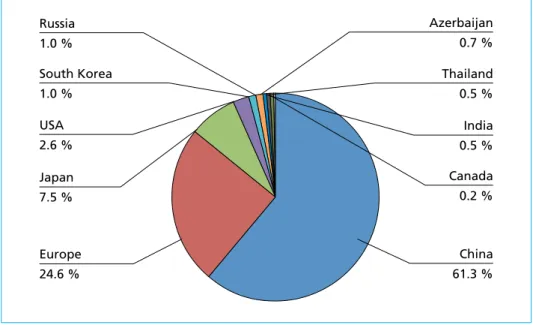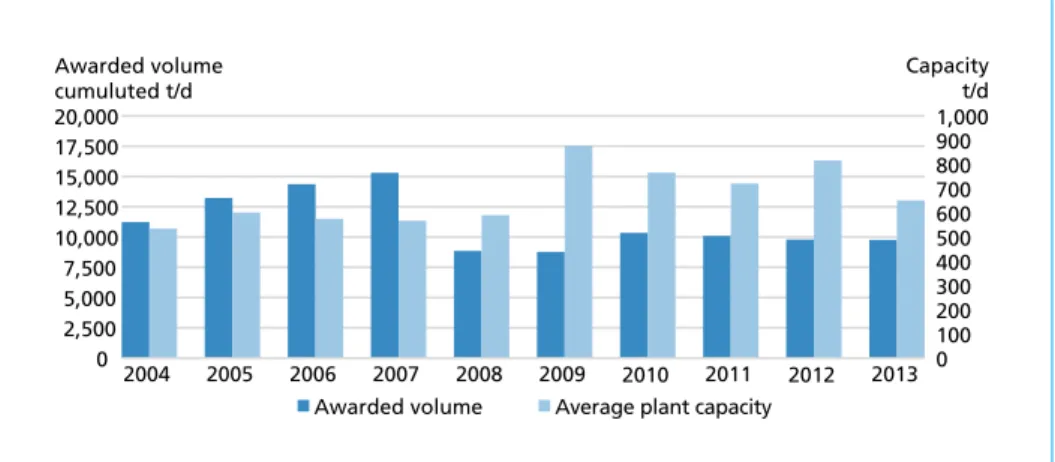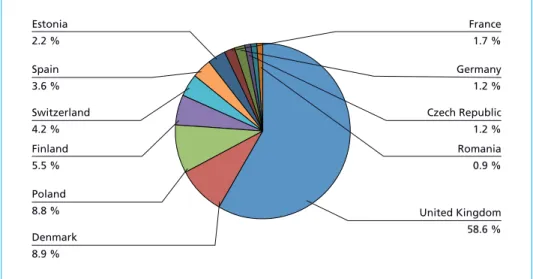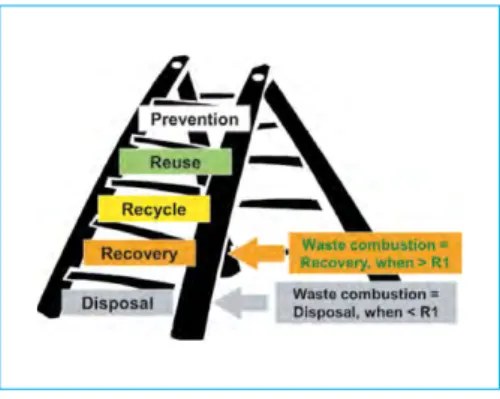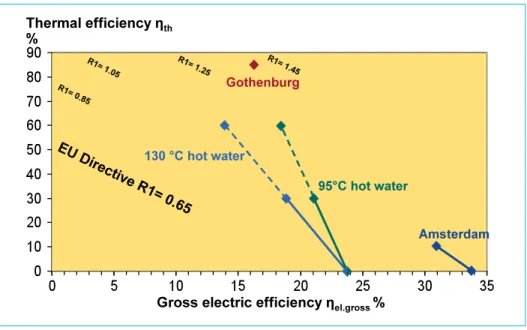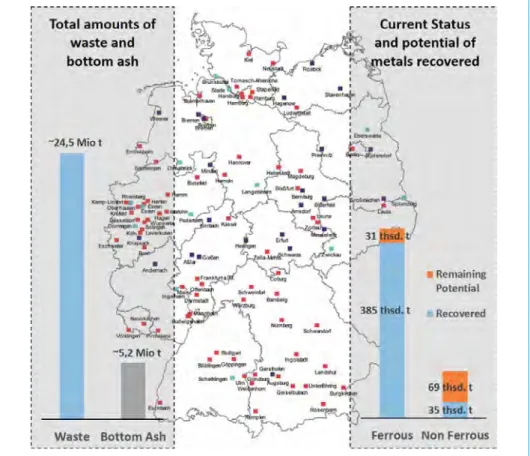57 The Development of Waste Incineration in Europe
The Development of Waste Incineration in Europe
Ulrich Martin
1. The state of the art... ...57
2. Implementing the Landfill Directive ...58
3. The market in Europe ...60
3.1. The position of the European market in a global context ...60
3.2. The European market ...61
4. Responsibility relating to thermal recovery ...65
4.1. Energy efficiency ...66
4.2. Material efficiency ...67
4.3. The old fashioned waste incineration plant as a highly efficient recycling station...70
5. Opportunities presented by the European market ...70
6. References ...71
1. The state of the art
... or should it be called: the art of storage? To put it more precisely: where are we with respect to landfilling, recycling, and thermal treatment? What is the European Union‘s position 15 years after a political framework was put in place to prevent municipal organic waste from being landfilled? Are any windows of opportunity still open to the waste management market – or will we soon reach a saturation phase brought about by the successful implementation of the relevant Directives?
In 1999 the European Union adopted the Landfill Directive aimed at preventing combustible waste from being landfilled. Landfilling municipal household waste was to be reduced to 75 percent of the value of the reference year – 1995 – by 2006 and to fifty percent by 2009. The third phase to be implemented by 2016 sets out a reduction down to 35 percent. The practical implementation of the Directive is up to individual Member States, thereby facilitating individual solutions while at the same time requiring industry to make the necessary adjustments.
Ulrich Martin
58
To promote the efficiency concept regarding recovery of various waste types, the Waste Framework Directive was issued – last revised in 2008. It defined types of waste and the treatment steps required for each type. Consequently, it also lays down a hierarchy outlining which treatment processes are preferable for a particular waste stream.
Both Directives set the framework for the European market to a large extent. On the one hand, the quantity of the waste to be treated encompassing the entire market volume is defined. On the other hand, an attempt has been made to define the quality of the treatment processes, which are then evaluated as adequate or insufficient with respect to the materials to be treated. The European market potential of individual industrial sectors is determined by these two factors. This potential cannot be expressed as a ge- neral value as it is dependent on individual implementation in terms of the respective national legislation.
2. Implementing the Landfill Directive
The European Commission describes the aims of the Landfill Directive as follows:
The objective of the Directive – Council Directive 99/31/EC – is to prevent or reduce as far as possible negative effects on the environment from the landfilling of waste, by introducing stringent technical requirements for waste and landfills. [2]
The milestones specified for the implementation of this objective ensure sustainable and economic feasibility. The targets set as a percent refer to the reference year 1995 and define the maximum permissible amount of landfill waste. The landfill rate must be calculated with respect to the reference year; i.e., the current amount of landfilled waste is referred to the total amount of waste in 1995.
As a result, an increase in municipal solid waste does not lead to an increase in the amount of landfilled waste. In real terms, this means that given the increasing volume of waste per capita, the actual recycling value must be higher than the specified value in the Landfill Directive suggests. Conversely, this also means that if the amount of waste decreases, fewer measures will be required.
For example, in order to reach these targets, Germany banned the landfilling of non- inert waste completely in 2005. Amongst other measures, financial incentives ranging from granting direct subsidies to specific recycling facilities to a landfill levy were put in place. The outright boom in Great Britain in the past few years was brought about by an incremental increase in landfill levies, which started out at seven GBP and currently amount to eighty GBP/t.
The large discrepancy in the implemented measures is reflected in the varying degrees of success in EU Member States. Landfilled waste in the EU 28 varied from almost zero to about one hundred percent. Since EU law applies to all countries within the EU, countries that subsequently joined the EU are likewise obligated to adopt the requi- rements of the Landfill Directive in their own national legislation. However, they are entitled to an extension period of four years, provided that the amount of landfilled waste at the time of joining the EU is in excess of eighty percent.
59 The Development of Waste Incineration in Europe
Figure 1 shows the current status of the diversion rate within the European Union by comparing the 2006 and 2012 values. The black lines represent the respective targets of the Landfill Directive, which are only valid for stable municipal solid waste streams. If one only takes into account the average amount of municipal waste generated per capita across Europe, this condition would be all but negligible, since the amount generated has risen approximately by a mere 5.7 percent since the reference year. If, however, it is applied to individual Member States, a very different picture emerges. For example the amounts shown for Portugal (+ 26.8 %), Denmark (+ 37.8 %) and Bulgaria (- 46 %) change significantly, while the values for Belgium (+ 2.9 %) and Great Britain (+ 4.0 %) remain almost constant. Nevertheless, it must be noted that there is an upward trend, particularly in the EU 15.
0 10 20 30 40 50 60 70 80 90
% 100
Recycling 2006/2012 Thermal treatment 2006/2012 Landfill 2006/2012 Germany Sweden Belgium
Netherlands DenmarkAustria
Luxembourg France Finland
EU
United Kingdom Ireland
Italy Estonia Slovenia Portugal
Czech Republic Spain
Hungary BulgariaPoland Slovakia CyprusLithuaniaGreece Latvia Croatia Malta Romania
Figure 1: Comparison of the landfill diversion rates of municipal waste in the EU 28; Member States who landfilled more than 80 percent of their municipal solid waste in 1995 can apply for an exception period of four years – this means fifty percent by 2013 and 65 percent by 2020: Bulgaria, the Czech Republic, Estonia, Ireland, Latvia, Lithuania, Poland, Romania, Slovakia and Great Britain
Source of Data: Eurostat – Statistical Office of the European Communitesn –. (2014). Retrieved from Environmental Data Centre on waste: http://epp.eurostat.ec.europa.eu/portal/page/portal/waste/introduction
Figure 1 also clearly shows that thermal treatment of municipal waste complements recycling methods. No imbalance between the two treatment methods was shown in any of the listed European countries with developed disposal systems. Rather, an increased rate of thermal treatment also indicates higher recycling rates. Furthermore, the figure illustrates which Member States made an effort to reduce landfilled waste in the specified time frame and where appropriate measures have fallen short.
Ulrich Martin
60
3. The market in Europe
3.1. The position of the European market in a global context
Over the past six years, the European market share was on average approximately one quarter of the worldwide market share. Taking individual years into account, the European share was stable at approximately 25 percent; except for 2008, which had a value of 37 percent [8].
Figure 2: Global geographic market shares of Plant Awards 2008 to 2013
Source: Vaccani, Zweig & Associates. (2014). Worldwide Market Share Analysis of Thermal Waste Treatment Plants. Zürich.
The Chinese market is especially conspicuous. On the one hand, this is surely attribu- table to the country’s size and large population; on the other, the market dynamics are also driven by a strong political will that evidently promotes thermal waste treatment.
Notwithstanding extensive construction over the past few years, the market is far from reaching saturation point. The installed and awarded capacity only accounts for ap- proximately 25 to 30 percent of the disposal volume. Taking into account the current low level of around 150 to 200 kilogram per year of municipal waste per capita, which, given steadily increasing industrialization is likely to increase, the Chinese market is set to remain dominant in the next decade.
The third geographical region with an appreciable and stable award volume is Japan.
Whilst the market has been saturated for years, the early emphasis on thermal treatment is currently generating a consistent market volume mainly driven by the building of new plants due to wear in older plants or modernization measures.
Europe 24.6 %
China 61.3 % USA
2.6 % South Korea 1.0 % Russia 1.0 %
Japan 7.5 %
Thailand 0.5 % Azerbaijan 0.7 %
Canada 0.2 % India 0.5 %
61 The Development of Waste Incineration in Europe
3.2. The European market
The long-term average of the market volume has remained largely stable in the past few years. A ten-year comparison shows an increase of awarded capacity up to 2007 at a maximum of 15,298 tonnes per day. In the wake of the financial crisis, the award volume shrank by almost fifty percent to 8,855 tonnes per day within a year. In the following five years, the award volume remained constant at an average of 9,752 tonnes per day.
It should also be noted that where the awarded capacity decreased slightly, the average plant capacity increased. This trend will not necessarily continue, as while on average 17 plants are awarded annually, individual projects have already left their mark on this statistic. Political and geographical factors as well as a shift in the market exert a stronger influence.
0 100 200 300 400 500 600 700 800 900 1,000
0 2,500 5,000 7,500 10,000 12,500 15,000 17,500 20,000
2004 2005 2006 2007 2008 2009 2010 2011 2012 2013 Capacity
t/d Awarded volume
cumuluted t/d
Awarded volume Average plant capacity
Figure 3: European plant awards and the associated plant capacities in the ten-year period from 2004 to 2013
Source: Vaccani, Zweig & Associates. (2014). European Market Share Analysis of Thermal Waste Treatment Plants. Zürich.
The primary market driver in Europe is currently Great Britain, whose market share increased to 68.6 percent last year, up from 56.5 percent in 2012 and 50.9 percent in 2011. This indicates that the consistent volumes of awarded plants in recent years are almost exclusively attributable to the British market, which in turn supports the rest of the European market. This development is driven by the European requirement aimed at diverting organic solid waste away from landfills and the fact that compared with other large industrial nations, the recycling quota in the UK lags far behind. Politics plays an important role as steadily increasing landfill levies have enabled advanced processes such as thermal waste treatment to gain an economic advantage and the press has publicized the fact that municipalities can save on levies with this option.
Ulrich Martin
62
Figure 4: European market shares of plant awards 2011 to 2013
Source: Vaccani, Zweig & Associates. (2014). European Market Share Analysis of Thermal Waste Treatment Plants. Zürich.
The existing landfill rates in particular show that other European countries have little or no ambition with respect to achieving the targets laid out by the EU. Excluding Great Britain, plant awards over the three-year period from 2011 to 2013 amounted to just 4,087 tonnes per day on average spread across 11 countries. It is remarkable that, apart from Great Britain, Switzerland, Denmark and Poland were the only countries to register successful awards in 2012.
It is equally evident that an ambitious and rapid implementation of the Landfill Direc- tive such as is currently underway in GB can only be achieved by means of larger plant capacities. At 53.3 % of the awarded plants in 2013, Great Britain achieved a market share of 68.6 % (2012: 50 % to 56.5 % and 2011: 42.9 % to 50.9 %). The explanation for this is that less effort is required to handle permit formalities and resistance at a local level if large plants are built because the specific cost per processed tonne per day is decreased.
In Poland for example, of the twelve plants that were initially planned, only six were successfully awarded and are currently in progress. Each of these plants will receive EU subsidies amounting 40 to 60 percent. Optimistically speaking, initial start-up is planned for the end of 2015. The remaining projects failed to reach a successful conclusion due to highly stringent award procedures and bidding conditions that fell short of market requirements. It is unlikely that these unsuccessful projects will be revived in the near future. It appears that the market is stalling until the results of the first wave of awards emerge. Further projects will probably follow as a result of these experiences.
As is the case in Poland, projects are being developed in the Czech Republic as a result of financial assistance made available by the EU. Several additional projects have been announced, but to date only one in Brno has been executed.
Poland
8.8 % United Kingdom
58.6 % Denmark
8.9 % Finland 5.5 % Spain 3.6 % Switzerland 4.2 % Estonia 2.2 %
Romania 0.9 % Germany 1.2 % Czech Republic 1.2 % France 1.7 %
65 The Development of Waste Incineration in Europe
Baltic countries are approaching the WtE market with caution. One plant was awarded in Lithuania in 2010 and an additional plant is being planned in Kaunas. Estonia is currently disposing of some of its residual waste in a plant in Tallinn, while Latvia re- mains hesitant. All in all, the situation in the Baltic countries is ambivalent. On the one hand, the economic and financial crisis left a significant impact; on the other, in view of their becoming part of the EU, a more robust economic development is becoming apparent. Given the size of the region and the fact that some projects have already been executed, the number of new plants will be limited to only a few.
Signs of a market development in other countries with severe deficiencies in their waste disposal structure are few and far between. Implementation of the legal framework does not appear to be possible despite the four-year extension that has been granted. Only strong determination in addition to adequate political support could still make timely implementation of the Directive possible. At present, political unrest and financial challenges make this unlikely and consequently, only insignificant dynamics can be expected. Given that the market in Great Britain will reach saturation, the European award volume will no longer remain at the current stable level but is expected to drop to the 2008 value, which computes to a reduction of at least a further thirty percent.
2014 will be a transition year since the market is still being supported by a few plant awards in Great Britain.
A short-term solution to the deficit in treatment capacity could be existing overcapaci- ties. In the past, recyclable material has proved to be extremely mobile. At a relatively low investment cost, it would be possible to create an infrastructure enabling the export of waste such as is practised by Great Britain and Ireland, for example.
Furthermore, the achievable efficiency of thermal recovery in Northern Europe, which is increasingly banking on combined heat and power (CHP)-based power plants with high and maximum efficiency rates, will occasion ecological and economic advantages.
Compared with Southern Europe, these advantages do not apply in the same measure due to factors such as the climate and other natural phenomena. In this respect, it is important to identify residual waste as a raw material and as a source of energy with great potential rather than a burden.
4. Responsibility relating to thermal recovery
Facilities for thermal treatment of organic waste got successfully rid of the status of pure inertization plants since measures aimed at using all streams present in waste are increasingly being implemented. Amongst others, such measures are based on the Waste Framework Directive, which defines a five-tier waste hierarchy detailing the best possible management of residual materials. For obvious reasons, waste prevention and reuse are the key methods for the best possible use of resources while avoiding emissions at the same time. However, the fact that our consumer society generates vast amounts of waste streams requiring disposal is in direct opposition to the principle of waste prevention.
According to the waste hierarchy, these waste streams are to undergo recycling, thermal recovery and finally, be disposed of by means of thermal processes. Thermal processes
Ulrich Martin
66
are differentiated according to an energy efficiency criterion, whereby all processes/
plants that exceed a specified efficiency level are granted energy recovery status.
These political and economic framework conditions have driven the development of thermal waste treatment systems and processes which extend beyond pure inertization.
As a result, not only are emissions harmful to the environment and substances affecting the climate reduced to a minimum, but savings in primary energy carriers are achieved since the energy contained in the waste is fully and efficiently utilized.
Modern grate-based combustion systems offer the means of combining efficient thermal treatment with recovery so that the inert material fed into the plant does not have to remain unused.
4.1. Energy efficiency
Within the Waste Framework Directive, the EU introduced an energy efficiency factor designed to split thermal treatment into two areas in 2008. The so-called R1 factor evaluates the electricity and heat generated in relation to the heat input from the fuel.
If a plant‘s energy efficiency exceeds the reference value of 0.65 (0.6 for old plants), it achieves recovery status, which gives it access to additional materials listed in the European Waste Catalogue thereby ensuring capacity utilization. Furthermore, as a result of this status, importing treated waste is permitted, which is why this represents a tool for limiting the inner-European trade of waste to plants equipped with adequate efficiency criteria.
Figure 5: Waste hierarchy and R1 factor
Plants that fail to achieve this value only achieve disposal status and are therefore classified one level below recovery. Con- sequently, the R1 factor demonstrates the political will with regard to increasing energy efficiency. As a result of the way the calculations are defined, plants with a high degree of combined heat and power achieve a value of 0.65 more easily than plants that only generate electricity.
However, combined heat and power is not useful or feasible to the same extent in all geographic regions of the European Union, which is why, due to its higher exergetic potential, electrical energy should re- ceive more favourable ratings or the climate factor currently under discussion should be implemented.
Figure 6 represents the efficiency requirements a thermal plant must meet in order to comply with an R1 factor of 0.65. This entails achieving a purely electrical efficiency of at least 24 percent or a purely thermal efficiency of about 57 percent. In addition, examples of two plants operating on two disparate concepts are shown. The Amsterdam
67 The Development of Waste Incineration in Europe
plant with its very moderate heat release but high electricity production achieves an R1 value of about 1.0 while the plant in Gothenburg, which primarily provides heat, received a rating of approximately 1.4.
Figure 6: Achievement of the R1 factor with varying electrical and thermal efficiency rates The European Environment Agency (EEA) published a study on reducing greenhouse gases describing how the waste management industry can contribute to climate pro- tection. According to this study, by 2008 this industrial sector had already contributed a reduction in CO2-equivalent emissions amounting to 48 million tonnes compared with 1995. And this potential has by no means been exhausted. If all EU Member States were to implement the Landfill Directive, an additional 62 million tonnes could be saved and if landfill were prohibited outright, savings would amount to a further 78 million tonnes [3].
4.2. Material efficiency
Holistic recovery of residual materials is only possible if thermal utilization of the chemically bound energy is accompanied by effective utilization of inert and non- harmful components.
The residual material produced by thermal utilization of waste can be broadly classified as three streams: bottom ash, boiler ash/fly ash and residues from flue-gas cleaning.
Bottom ash fractions account for the largest share by far. They consist of minerals, ferrous and non-ferrous metals as well as glass.
State-of-the-art technology permits separation of ferrous metals using magnetic separators and non-ferrous metals by means of eddy current separators arranged downstream of the wet discharge process. This can occur directly downstream of the
Ulrich Martin
68
thermal process in the WtE plant or centrally at a bottom ash treatment facility. Using conventional technology, about 92.5 percent of ferrous and approximately 34 percent of non-ferrous metals can be separated [6]. The low separation rate of non-ferrous metals is attributable to the fact that the granular size of the particles in question is smaller than is the case with ferrous metals, causing them to be incorporated into larger bot- tom ash particles that cannot be separated by an eddy current separator. The example showing Germany (Figure 7) demonstrates that the bottom ash‘s potential, especially with respect to non-ferrous materials, remains untapped.
Figure 7: A comparison showing the recovered share in Germany and the remaining potential of metals present in bottom ash (State: 2009).
Source: Umweltbundesamt. (2010). Verbesserung der umweltrelevanten Qualitäten von Schlacken aus Abfallverbrennungsan- lagen. Dessau-Roßlau.
Apart from The Netherlands, where close to one hundred percent of bottom ash is treated in special plants, the leading country in terms of bottom ash treatment is Swit- zerland. A central facility which will treat the bottom ash produced by several thermal recovery plants is being erected in the canton of Zürich. The recovery potential of urban mining far exceeds established measures. Theoretically, it is possible to recover valuable resources such as gold and silver as well as rare earth elements. A further module for separating raw materials containing glass is also possible. The facility is being erected
69 The Development of Waste Incineration in Europe
under the umbrella of a regional waste management organization, the ZAF – Zürcher Abfall Verbund – and the process was developed by a foundation especially established for this purpose, the ZAR – Stiftung Zentrum für nachhaltige Abfall- und Ressourcen- nutzung [Foundation Centre for Sustainable Utilization of Waste and Resources]. Its aim is to achieve the best possible recovery from bottom ash and thereby to effectively minimize landfill demand.
The ZAR process is based on dry discharged bottom ash in order to increase the above- mentioned separation rates and to enhance the quality of the separated materials. The process does not involve the numerous chemical reactions that take place during wet discharge when water is added. Tests have shown that especially with regard to non- ferrous metals, significant increases in recovery rates ranging from 56 to 80 percent [1] can be expected. The already high recovery level currently applicable to ferrous metals can be increased by an additional 8 to 26 percent. Non-ferrous metals make a valuable contribution toward the economic efficiency of such facilities because the revenue from non-ferrous materials is far higher than that from ferrous metals. The improved recovery of materials achieved by this process applies not only to increased amounts, but is also influenced to a large extent by the improved quality of the dry discharged bottom ash [1].
In order to reliably ensure this reuse potential, Martin developed a special module consisting of a ram-type discharger operated in dry mode and an air separator which are compatible with existing discharger systems. Key factors that were taken into con- sideration included simple handling of the dry bottom ash and in particular, that the combustion system would not be subjected to influences such as the ingress of false air or similar.
The non-ferrous metal samples shown in Figure 8 were taken from a Swiss recovery plant equipped with this module. The samples were taken immediately downstream of the module prior to any further treatment measures. Only air separation was carried out to remove mineral materials smaller than one millimetre to prevent the accumulation of dust. Of note here is the pure form of the aluminium and copper fractions, which make the yield sequence described above possible.
Figure 8:
Non-ferrous samples in a thermal recovery plant – WtE plant in Monthey, Switzerland – after dry discharge without further treatment measures
Ulrich Martin
70
Furthermore, apart from reuse of the metal fractions, it is common practise in various EU countries to use the mineral fraction for various purposes including building roads, treating disused mine shafts and sealing existing landfills. Denmark and The Netherlands score the highest reuse rates of one hundred percent and 98 percent [5].
4.3. The old fashioned waste incineration plant as a highly efficient recycling station
If the combined potential of energy recovery from the combustible share and the reuse potential of the inert fraction contained in residual material is taken into consideration, a modern WtE plant serves a far greater purpose than merely reducing the volume of residual material, the latter being the common view to this day.
The steady further development of process engineering components including intel- ligent process control has meanwhile made far-reaching reuse of the constituents of residual waste possible. Consequently, it has become necessary to redefine previously valid standards. Innovative combined energy concepts referred to the lower heating value of the fuel can achieve energetic efficiency rates of over one hundredd percent, a fact which is in keeping with energy conservation. This can be substantiated by the thermodynamic definition of the heating value and is made possible by the additional utilization of the latent heat present in the flue gas.
Likewise, thermal treatment of inert material at fuel bed temperatures of up to 1,000 °C is viewed as the first step in the process that frees these resources from contaminants and prepares them for reuse. Organic and other pollutants such as heavy metals are reliably removed from the raw material and filtered out of the flue gas by flue-gas cleaning units.
In view of this background, thermal treatment of waste should be re-evaluated and reclassified to a class comparable to recycling. Above all, an honest assessment of the ecological and economic effects of the individual treatment processes that includes all the necessary pre and post treatment steps must be undertaken.
5. Opportunities presented by the European market
Despite a decrease in award volumes, the European market will remain one of the most important markets worldwide in the future on account of its financial volume.
In this field there are still large untreated material streams requiring sensible recovery.
Tapping these streams must also involve the support of the industry so that by means of progressive and, above all, reliable technology, any reservations pertaining to thermal recovery can be overcome.
At the same time, refurbishment of old plants and technological modernisation mea- sures constitute a secure market potential that can be driven forward by steady flow of innovations. The grate-based combustion system will continue to play a prominent role since its robustness, which is the product of decades of development, facilitates
71 The Development of Waste Incineration in Europe
the highest possible degree of availability and cost-effectiveness. As the same time, new technologies offer the lowest emission values that do not impair efficiency, but instead make high energy and material production rates possible.
6. References
[1] Blatter, E., zur Mühlen, M., & Langhein, E.-C. (2014). Die praktische Umsetzung der Trocken- entschlackung. In K. J. Thomé-Kozmiensky, Aschen, Schlacke, Stäube. Neuruppin.
[2] European Commission. (2014). Waste -Environment - European Commission. Retrieved from http://ec.europa.eu/environment/waste/landfill_index.htm
[3] European Environment Agency. (2011). Waste opportunities, past and future climate benefits from better municipal waste management in Europe. Denmark.
[4] Eurostat (Statistical Office of the European Communites). (2014). Retrieved from Environmental Data Centre on waste: http://epp.eurostat.ec.europa.eu/portal/page/portal/waste/introduction [5] ISWA - Thermal Treatment Subgroup. (2006). Management of Bottom Ash from WTE Plants.
Copenhagen.
[6] Umweltbundesamt. (2010). Verbesserung der umweltrelevanten Qualitäten von Schlacken aus Abfallverbrennungsanlagen. Dessau-Roßlau.
[7] Vaccani, Zweig & Associates. (2014). European Market Share Analysis of Thermal Waste Treat- ment Plants. Zürich.
[8] Vaccani, Zweig & Associates. (2014). Worldwide Market Share Analysis of Thermal Waste Treat- ment Plants. Zürich.
Ulrich Martin
72

